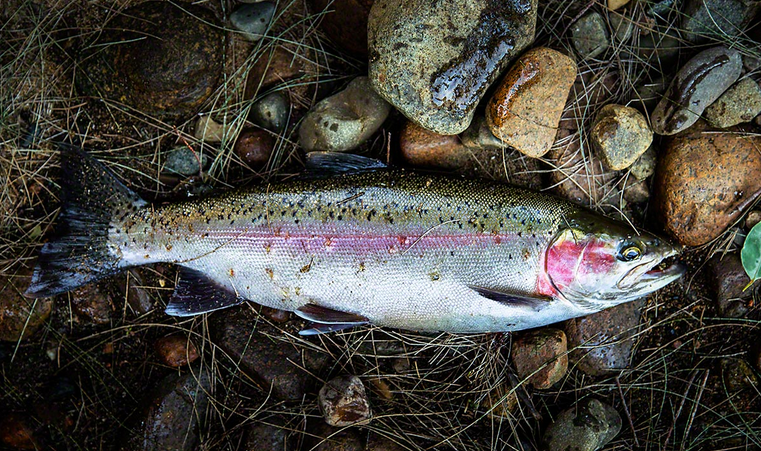| How to Make a Fishing Spear The Primitive Way
Originally written by Paul Scheiter, Hedge Hog Leatherworks |
| It is important to mention that all skills using modern tools can be replicated in a primitive fashion. In fact, the ultimate goal of the survivalist is NOT to build an arsenal of high tech gadgetry that will allow him/her to “survive” in the wilderness. Rather, the intention is to use modern equipment until the skill is mastered and to gradually liberate yourself from relying on it. As a survivalist, the ultimate freedom is being able to walk humbly into the wilderness, with nothing but the knowledge in your head and a knife in your sheath (preferably a Hedgehog sheath!)… and yes, the true purist goes a step further by using only stone tools.
As Tom Brown Jr. teaches, a backpack filled with gear is a lifeline back to society, a burden, and evidence of the fact that your skills are lacking. Have I mastered this level of survival? Not even close. But I am committed to developing it and I continually force myself to shed those trappings of the modern world. It doesn’t happen all at once, but rather in increments. Next time you go camping, leave the tent at home… force yourself to create a debris hut, or leave the matches and force yourself to make a bowdrill fire. This article will give you one more skill, but if you don’t practice and make it your own, then no amount of knowledge will be enough to sustain you in the wild… so please don’t be an armchair survivalist! Get out there and let the learning happen! |
|
|
 |
| Choosing The Sapling This is the same tree I used last month in conjunction with the Hoffman Harpoon. You are going to want a tall, straight sapling, about two inches in diameter. I start by creating a pressure cut around the perimeter of the tree with my Tracker Knife. There is no carving involved in this technique. You are simply applying heavy pressure while rotating the knife around the wood. Do this to the thick end of the tree: the part that is closest to the roots. |
|
|
 |
| Carve One Side After making the pressure cut, I carved away only on the short side. As I shave away the wood, the short end becomes pointed and the long end remains flat. |
|
|
 |
| A Clean Break The wood has now been weakened exactly where I want. One easy tap with the back of my Tracker Knife causes a clean break to occur. Discard this short section of stick. |
|
|
 |
| Brace and Align the Knife Secure the small end of the sapling against a sturdy surface such as a fallen tree or a large rock. Now place the straight portion of your knife across the freshly broken end. Make sure it rests exactly down the middle. |
|
|
 |
| The First Split Find a wrist-thick piece of wood and tap the back of the knife. This will let the knife split the wood in a very easy and controlled manner. |
|
|
 |
| After Tapping A quick view of the sapling as it should be after the first tapping. Do not go very far and be sure to keep the split running EXACTLY down the middle. |
|
|
 |
| The Second Split Now make another split using the exact same technique. This time it should be perpendicular to the first split. This will divide the end of the sapling into four even sections. |
|
|
 |
| Stop Drop and Cut Now before you split too far into the wood, stop and cut a peice of cordage about four feet long. In this picture I am using natural jute twine, which is available at most hardware stores. |
|
|
 |
| Lashing Now lash the cordage around the sapling about 18 inches or so from the end. This will ensure that the wood does not keep splitting past this point. |
|
|
 |
| Finish the Splits Continue both splits until they run all the way up to the lashing you just finished. |
|
|
 |
| Spreader Twigs Now find and carve two small twigs that are just a bit longer than the width of the sapling. |
|
|
 |
| Work Em’ In! One at a time, slide the twigs as far up and close to the lashing as possible. You may have to pry the wood with your hand to make the twigs fit. The spear really starts coming to life here as the four sections spread out. |
|
|
 |
| One Final Lasing Now lash those twigs securely into place with another section of jute twine. |
|
|
 |
| Carve the Outside Begin shaving the outside of each prong section by carving away from you with the knife. |
|
|
 |
| Final Touches Then add the finishing touches by shaving out some of the inside of the prongs. To do this, stabalize the spear and then slowly and gently pull the knife toward you using the curved portion of the blade to cut. Watch your fingers! |
|
|
 |
 |
| The Finished Product Here is the completed spear with strong lashing and all four prongs sharpened. |
|
|
 |
| The Next Step Well, now I have to actually use the spear but I’ll save that for another article. Summer is coming and there will be plenty of hot days to test out this tool and learn the next series of lessons. I hope you enjoyed this article.
|


